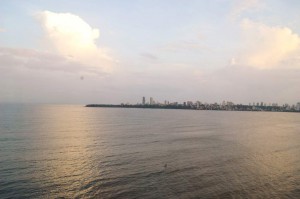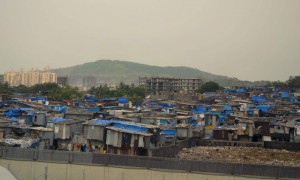Indian impressions
Visit to India: December 27, 2014 to January 09, 2015
Purpose: To attend a family wedding
Route taken: Karachi-Colombo-Mumbai-Hyderabad and return
Destination: Hyderabad. Stopover in transit in Mumbai for about 15 hours on way out, and about 6 hours on return leg
Weather: Perfect throughout, high in mid-20s C, low 13 C, generally dry, brisk breeze at times
Karachi, December 23, 4 days before departure. I get a call from Mumbai. It is someone from Indigo Airlines customer services. Indigo is the privately-owned budget airline I will be taking for the round trip from Mumbai to Hyderabad. The person informs that my return flight from Hyderabad to Mumbai will have a delayed departure and the airline is profusely sorry. He offers that I can change to another flight if I wish to. How long is the delay, I ask? Fifteen minutes, he says. I almost laugh out loud. The flight will be delayed a measly 15 minutes and this man has made an international call to inform me, more than 2 weeks in advance. I wonder what he would say if I told him that we are used to PIA delaying flights by unlimited hours, and informing you only once you reach the airport, or worse still and often enough, once you are actually on board and sitting in the plane.
But that’s Indigo for you; a fine airline in every which way. Efficient online booking; smart, educated and gracious staff at check in; new, spotless planes; pretty, young, courteous and efficient cabin crew; on-time departures every time; luggage on carousel already by the time you de-board and reach arrivals lounge….. and more. I have experienced all this on at least 3 trips and so this is definitely not a one-off good experience.
Mumbai – bustling, vibrant, crowded. Hawkers at traffic lights sell books, not just newspapers and magazines. I can only conclude that if they are selling, people must be buying. And that the reading habit extending well beyond tabloids and glossies, is strong in the populace.
Countless number of British-era buildings, all over the metropolis, (and especially in the Gateway to
India and Nariman Point environs) very well-maintained and a pleasure to view.
Leafy, green neighbourhoods.
Romantic, exciting sounding names of city areas and streets – Cuff Parade, Marine Drive, India Gate, Hanging Gardens, Bandstand, Nariman Point, Apollo Pier Road, Churchgate, Flora Fountain, King’s Circle, Victoria Gardens, Mahatma Gandhi Marg ….. names that reflect history and a harmonious blend of several cultures and religions.
Brand new airports – both the domestic and the international; the latter especially humongous, well-planned and well-designed, organized, high-tech.
True anecdote:
On the return journey from Hyderabad to Mumbai, our group of 5 had 6 hours in transit in Mumbai before catching the Sri Lankan flights to Colombo and then to Karachi. Option 1 was to spend the 6 hours in the international airport itself. Option 2, lug the baggage (5 suitcases, 1 carton) in a cab (or 2) to one of the several 5 start hotels a stone’s throw from the international airport (JW Marriott, Kempinski – to name just 2) and hang out there till reporting time for the onward flight.
Option 3 – the one we went for: collect luggage from carousel in domestic arrivals lounge (it comes within minutes of your reaching the lounge), walk over to Trident Airport Services counter (30 paces from carousel and inside the domestic arrivals lounge itself), deposit your luggage there for a few hours at a fairly nominal fee, walk out and explore Mumbai for the few hours available, and then return to the international airport and receive your left luggage there!
Call it what you want – modern convenience, service excellence, customer focus, efficiency, or something else.
Mumbai:
Nasty traffic jams throughout most of the day. No one running red lights though. Eases up at night and we missed the rush during our city outing starting at 9.30 pm and ending about 1 a.m.
Smartly turned out young people galore downtown. Especially Mumbai girls ….. Hindu, Muslim, Catholic, Parsis, others.
Magnificent British era buildings by the scores – residences, offices, public buildings.
Countless tall buildings, tightly packed on Mumbai island itself – like a mini Manhattan. Mukesh Ambani’s 1 billion dollars tower home (the world’s most expensive home), comprises 27 floors jutting skywards in the thick of it. And quite dismayingly, arguably the worst designed building in the whole neighbourhood. Rumour has it that he uses it only for parties and to house guests, and does not live there himself, because after it was completed, his soothsayer pronounced that bad luck will come his way if he lived there. So he and his family continue to live in their palatial house in another upscale area on the island.
And starkly in contrast to the high-rise buildings, a huge number of squatter colonies practically all over the city with few areas excepted, with individual hovels made primarily of waste materials, housing entire families within a ‘covered space’ of less than 10 square meters.
And then there is the ‘Sea Link’, a few years old only. A 4-6 kilometers long, 6-lane, dual carriageway toll expressway, built over the sea completely on massive reinforced concrete pillars buried deep into the seabed. It has a long centre span suspension section with no pillars. An absolute marvel of technology and state-of-the-art engineering. Cherry on the pie being its instantly appealing aesthetics and visual appeal.
Huge choice of places to visit – museums, art galleries, theatre, cinema, malls, gourmet restaurants, parks, beaches, street markets …. For visitors, accommodation to suit all budgets and tastes. On a previous visit a couple of years ago, we had stayed on the 18th floor of the plush Oberoi Trident hotel at Nariman Point, with a ceiling to floor glass wall that gave you a breathtaking view of the semi-circle bay of Mumbai opening out to the Indian Ocean. The proverbial room with a view definitely!
You drive around the city and cannot help but get the impression that the city denizens by and large are alive, have a deep sense of belonging, are thoroughly involved in living life to the full, and clearly committed to compete in a highly competitive environment, irrespective of their vocation, or religion or social status or the challenges they have to face. You see this positive attitude in taxi drivers, in corporate executives, in street vendors, in the young and not so young females zipping around on their 2-wheelers, in working people, in families picnicking on the sea-fronting Marine Drive or on the immensely popular Chowpati beach, with the much-hyped ‘Chowpati ki chat’ living up to its formidable reputation.

Haji Ali Dargah, visited daily by thousands, Muslms and Hindus alike, and accessible only at low tide, becuase at high tide the path leading to the island on a smallisland gets submerged
Around India Gate and the famous Taj Mahal Palace Hotel, we stopped at 2 upscale restaurants to have dinner. Both were full. One told us to come back in 40 minutes. We went to a third, an elegant bistro-style place called The Table. Slight wait but we got a table. Great ambiance, chic clientele, good (not great) food, quick and courteous service. English speaking waiters.
Downside of Mumbai? The maddening, stress-inducing traffic, the sheer number of people everywhere, the myriad, inhumane shanty towns and the ubiquitous poverty, the high level of air pollution in some areas, Some visitors found the city to be dirty; even stinking. Truthfully, this is totally contrary to what I saw and felt, and am quite surprised that some perceived Mumbai thus. Cannot help but wonder which city areas they were mainly moving around in…..
I could live in Mumbai. I could thrive in Mumbai. I think cities like Mumbai invigorate you and keep you really alive. I am sure there are negative societal issues at play too, for the residents that a visitor generally does not experience or perceive. For instance, are Muslims discriminated against in subtle, not so obvious ways? Is there class exploitation? What about utilities? Do Mumbaites face water, gas, electricity shortage? Is crime or drugs or alcoholism a real problem?
I don’t have ready answers to these questions. Every big city, anywhere in the world has its problems and its challenges. But from what I saw, (and I do believe my innate ability at seeing beyond the obvious is remarkable) it would appear that Mumbai does not seem to be burdened with any overwhelming social tribulations that would make everyday life miserable for the average citizen. Politics and religion, the 2 most divisive issues in any society, seem to have little significance in Mumbai society. Peacefully coexisting are Hindus, Buddhists, Jains, Christians, Parsis and Muslims, with minority sects like Ismailis and Bohris in fairly large numbers. Work hard and play hard is the spirit of the city, and while the people may be more businesslike in their interaction than say the residents of laid-back Hyderabad, there is great tolerance and harmony in the cosmopolitan society of this Indian city by the ocean.




Well written as always with very informative insight on a city that is generally perceived to be different. One always appreciates the modernization of cities and it is very unfortunate that we are still trying to spend hours looking for petrol, rather than doing something useful. Such a shame…
I am absolutely delighted to read your post – I think, if I had the ability to articulate as well as you do, I would have posted it ditto – and 25 years ago when I went to Bombay for the first time (since 1976 anyway) as my wife to be is from Bombay and grew up near Kemp’s Corner.
You have hit the nail on the head; despite the very conservative elements in Bombay (I refuse to call it Mumbai except on postage labels), it is a progressive city. It has its issues like most metropolis. Congested as hell during the day, police corruption, etc. But, there is a vitality that is seen, especially at night.
I have been to Bombay about 3-4 x as many times I have visited Karachi and look forward to each visit, especially to Willingdon Club, a 100-year old club founded by the Brits in the colonial days. Maybe, it comes from my parents who grew up there but I think it comes from connecting to a culture in a way that I find it difficult to connect with in Karachi. I feel no sadness about saying it. A trip to a place like Bombay is a stark reminder of what Karachi was like in the early 60s.
Thank you for a wonderful post.
only Pakistan has a problem with Muslims. So sad!
I plan to visit India one day. Inshallah
Very well written, Bob Bhai.
Excellent articulation of the experience…..Since I too was there with my family during the same period and therefore cannot agree more than what you have written above. Great read!
Hi Zohare: A great read – you saw so much, well beyond the surface. I only hope that we can maintain the tolerance and harmony.